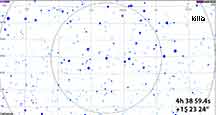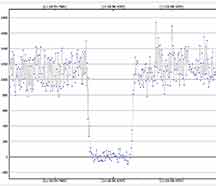


This is one of the brightest occultations of the year. 8.4 will be quite easy to get even at 1/60 sec cadence. I am making this page for Karl and Kirk and only maybe for myself. I'm waiting for clarity on the weather and smoke for Graniteman before deciding whether to commit to it, and if so, I'll skip this event.
The event is high in the sky, in Taurus. at 54 degrees altitude in azimuth 118, in the SE.
 |
 |
 |
I bailed on my GraniteMan plans, due to smoke and thunderstorms. So, I did actually go for this one. I though Kirk would be up the coast and so I headed for Locatelli Meadow. When I arrived, I could see Kirk already at that tiny pullout spot and set up and doing object acquisition. So I "Y" turned and sped back south, to arrive at the pullout to the Christmas tree farm, and got a good 1.2s high precision occultation there. We were rather close, but given the high precision of the timings, still far enough apart to fix the position of the asteroid well, I hope. Too bad this bright event high in the sky had no other claimed observers. I never did hear from Karl.
I observed at 1x (1/60s field mode) with my regular set up. Even used the parameters of the event to include diffraction into the solution. Timings are given 1-sigma accuracy of less than 1/100th second.
D 11:26:55.7631 (.0017, .0041, .0082)
R 11:26:56.9951
(.0017, .0041, .0082)
S/N = 6.46, magdrop =5.15 Duration=1.232 seconds
 |
 |
 |
 |
 |
 |
We've learned of a software error in PyMovie such that it randomly puts photmetry in the wrong field within a frame. It only affects results if you use 1/60s setting and analyze in field mode. Thus, it affects this occultation and calls for a re-analysis. The solution until PyMovie is fixed, is to use LiMovie for the photometry.Kirk is re-analyzing his results using LiMovie, and I've done that tonight, and here are the results... I sent in my revised LiMovie data report to IOTA on Jan 28.
Nolthenius results - PyOTE Log File
|
I again included the data enabling calculation of diffraction and stellar diameter, hence the wiggles in predicted brightness. |
Zoomed in. The D looks correctly placed |
And the R as well. The diffraction oscillations are not well seen in the photometric data, though. |
Kirk Bender
New reductions in January '23 using LiMovie instead of PyMovie. Analyzed in field mode, 1/60s. " Here's my results from doing Killia in limovie then PyOTE (no diffraction). No spikes in D or R. When I first tried it in limovie, I used link but drift tracking for the target like you did, but at the D, the target aperture lost the target and started wandering around. I finally found it, but well after the D. The second try with these results I used tracking off with link and it stayed on target. Same thing with Mattiaorsi, using drift on the target made it wander after the D. I still haven't found evidence of swapped fields with limovie."
|
LiMovie analysis, entire light curve. Target in blue |
Zoomed in on target's occultation in LiMovie |
PyOTE solution and error bars - very tight! |